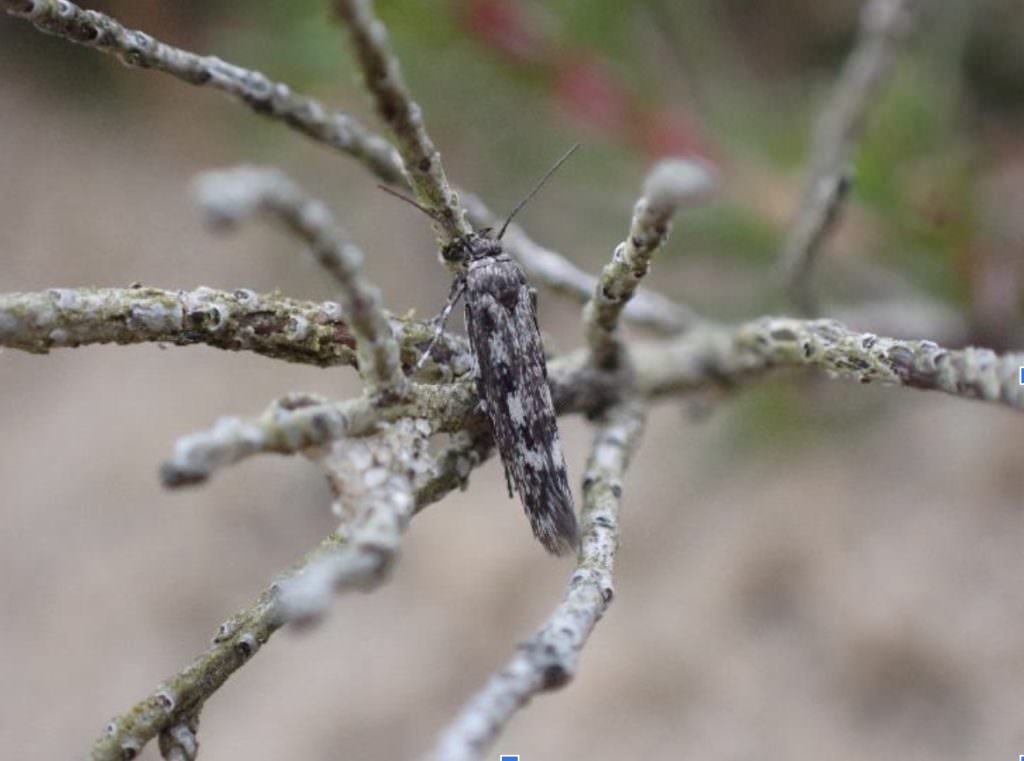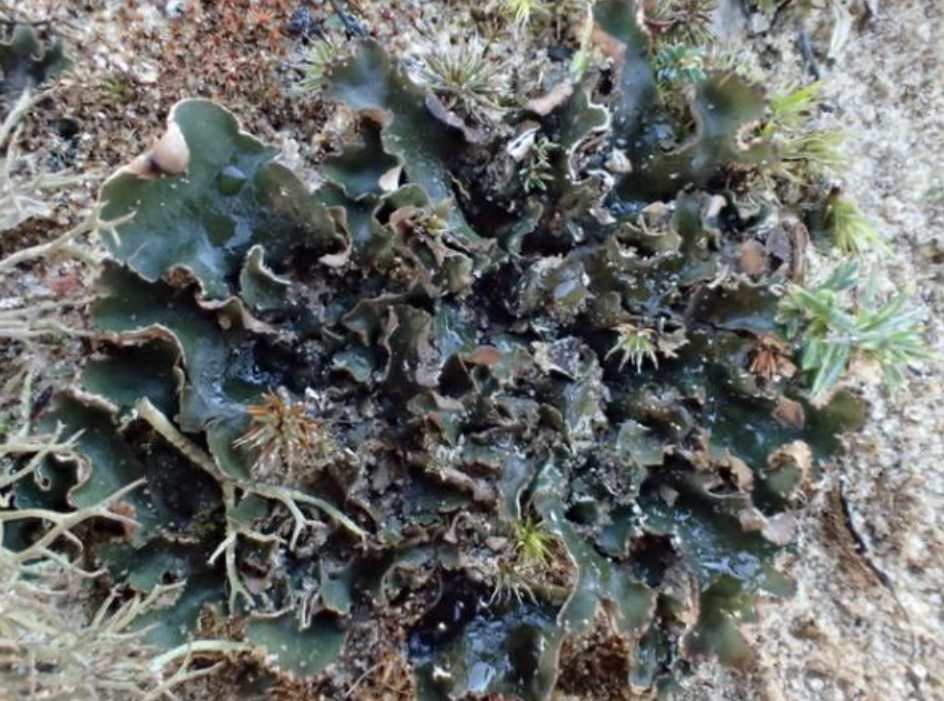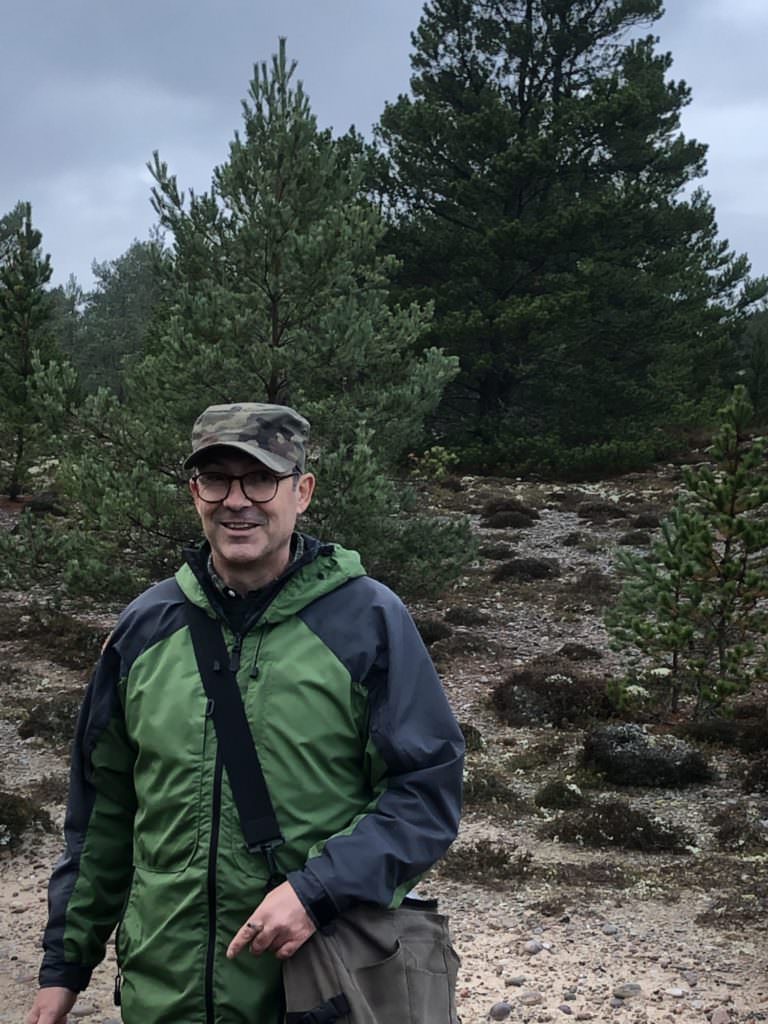The Project is moving apace, with a major focus on exploring some potential sources of funding. We are excited to report that the Hinterland Trust is discussing forming a partnership with our neighbour, the Findhorn Dunes Trust, to apply for a grant scheme.
We have continued to work on project design, learning from similar projects in north Scotland. We had a very successful meeting with Butterfly Conservation (BC) in October. BC were very enthusiastic about our dune habitat restoration proposals.
BC, the RSPB and Scottish Forestry and Land (SFL) are working on a number of dune restoration projects on the Moray Firth. BC’s Head of Conservation, Dr Tom Prescott, sent us their records of moths for the Findhorn Dunes, which comes to an absolutely incredible 402 species!

Scythris empetrella on a heather stem
The Portland moth, a rapidly declining species and recorded at Findhorn Dunes, is a particular priority for BC. They are also interested in establishing the current status of the Lunar Yellow Underwing moth on the Hinterland. This moth is extremely rare in Scotland and has been recorded on the Hinterland, but not since the 1990s. Is it still here…? BC are also interested in the status of the grayling butterfly and exploring potential habitat creation for the small blue butterfly – whose food plant is the kidney vetch, which is found on the dunes. We hope that BC will be able to advise us further as the project develops, and that they will visit us in the summer to hold a butterfly survey event.

Common Blue butterfly Sean Reed
Converting carefully selected stands of tall gorse to dune grassland and heath will create ideal conditions for moths, butterflies, and other insects. Many of these are found at only a handful of locations in Scotland.
Removing young pine trees from areas of dune heath will prevent this Scottish Biodiversity List habitat being lost forever. As well as being the main habitat for a host of rare lichens, including the endangered red data book Felt Lichen, dune heath is the home of the moth Scythris empetrella, found at only two sites in Scotland, Findhorn Dunes being the most important. Empetrella needs heather stems growing in sand to complete its life cycle, highlighting just one of the intricate unseen ecological relationships which are playing out, and are threatened, on the dunes.

Endangered felt lichen. Heather Paul
Both the Findhorn Hinterland Trust and Findhorn Dunes Trust have been doing this important ecological work over the last few years, mostly by work parties with hand tools. Our Land Manager, Kajedo Wanderer, has done a fantastic job in clearing early-stage scrub from top priority and highly sensitive dune heath areas. Removal of long-established gorse and dense areas of young trees is too much for hand tools and work parties, however. It’s time to bring in contractors with machinery to restore open dune habitats that have been lost.
Our project is designed to harness the elemental force of the wind – a nature-based approach, which will help maintain open sand dune habitats. We were delighted to receive a ringing endorsement of the project from the UK’s foremost authorities on lichens, Sandy and Brian Coppins (Royal Botanic Garden, Edinburgh).
The project team is very pleased to have been invited to RSPB Culbin reserve to see the dune restoration work that the RSPB (Europe’s largest nature conservation charity) are doing there. We will report back next time.
Sean Reed.
Findhorn Dunes Restoration Project
November 2023


















Dune Restoration Project Update
The Project is moving apace, with a major focus on exploring some potential sources of funding. We are excited to report that the Hinterland Trust is discussing forming a partnership with our neighbour, the Findhorn Dunes Trust, to apply for a grant scheme.
We have continued to work on project design, learning from similar projects in north Scotland. We had a very successful meeting with Butterfly Conservation (BC) in October. BC were very enthusiastic about our dune habitat restoration proposals.
BC, the RSPB and Scottish Forestry and Land (SFL) are working on a number of dune restoration projects on the Moray Firth. BC’s Head of Conservation, Dr Tom Prescott, sent us their records of moths for the Findhorn Dunes, which comes to an absolutely incredible 402 species!
Scythris empetrella on a heather stem
The Portland moth, a rapidly declining species and recorded at Findhorn Dunes, is a particular priority for BC. They are also interested in establishing the current status of the Lunar Yellow Underwing moth on the Hinterland. This moth is extremely rare in Scotland and has been recorded on the Hinterland, but not since the 1990s. Is it still here…? BC are also interested in the status of the grayling butterfly and exploring potential habitat creation for the small blue butterfly – whose food plant is the kidney vetch, which is found on the dunes. We hope that BC will be able to advise us further as the project develops, and that they will visit us in the summer to hold a butterfly survey event.
Common Blue butterfly Sean Reed
Converting carefully selected stands of tall gorse to dune grassland and heath will create ideal conditions for moths, butterflies, and other insects. Many of these are found at only a handful of locations in Scotland.
Removing young pine trees from areas of dune heath will prevent this Scottish Biodiversity List habitat being lost forever. As well as being the main habitat for a host of rare lichens, including the endangered red data book Felt Lichen, dune heath is the home of the moth Scythris empetrella, found at only two sites in Scotland, Findhorn Dunes being the most important. Empetrella needs heather stems growing in sand to complete its life cycle, highlighting just one of the intricate unseen ecological relationships which are playing out, and are threatened, on the dunes.
Endangered felt lichen. Heather Paul
Both the Findhorn Hinterland Trust and Findhorn Dunes Trust have been doing this important ecological work over the last few years, mostly by work parties with hand tools. Our Land Manager, Kajedo Wanderer, has done a fantastic job in clearing early-stage scrub from top priority and highly sensitive dune heath areas. Removal of long-established gorse and dense areas of young trees is too much for hand tools and work parties, however. It’s time to bring in contractors with machinery to restore open dune habitats that have been lost.
Our project is designed to harness the elemental force of the wind – a nature-based approach, which will help maintain open sand dune habitats. We were delighted to receive a ringing endorsement of the project from the UK’s foremost authorities on lichens, Sandy and Brian Coppins (Royal Botanic Garden, Edinburgh).
The project team is very pleased to have been invited to RSPB Culbin reserve to see the dune restoration work that the RSPB (Europe’s largest nature conservation charity) are doing there. We will report back next time.
Sean Reed.
Findhorn Dunes Restoration Project
November 2023